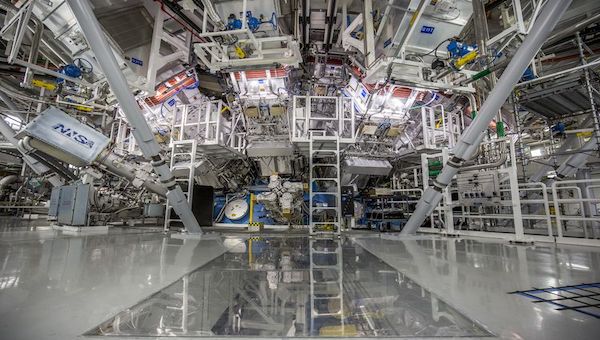 The target chamber of LLNL's National Ignition Facility Laser and Target Area Building in California. Lawrence Livermore National Laboratory
The target chamber of LLNL's National Ignition Facility Laser and Target Area Building in California. Lawrence Livermore National Laboratory
NUCLEAR FUSION BREAKTHROUGH COULD DELIVER CLEAN POWER TOO CHEAP TO METER
BY: LLOYD ALTERSITE: TREE HUGGER
TRENDING
Activism
AI
Belief
Big Pharma
Conspiracy
Cult
Culture
Economy
Education
Entertainment
Environment
Faith
Global
Government
Health
Hi Tech
Leadership
Politics
Prophecy
Science
Security
Social Climate
Universe
War
Is this a Wright Brothers or Zephram Cochrane moment that changes everything?
The Lawrence Livermore National Laboratory (LLNL) accomplished what's being called the holy grail of fusion research: It achieved fusion ignition. In other words, it managed to get more energy out than it put in ... sort of. There's not much of it, but it is still a big deal.
— Lawrence Livermore National Laboratory (@Livermore_Lab) December 13, 2022
BREAKING NEWS: @ENERGY and @NNSAnews today announced the achievement of #FusionIgnition at @lasers_llnl — a major scientific breakthrough decades in the making that will pave the way for advancements in national security and clean energy: https://t.co/ree9UAJSkf pic.twitter.com/w3oBH06pe8
In a press conference , U.S. Energy Secretary Jennifer Granholm said, “This is one of the most impressive feats of the 21st century.” She then compared it to the Wright Brothers at Kitty Hawk and noted, "But we’re not yet ready for a transatlantic flight."
According to the LLNL , it achieved what it calls a "scientific energy breakeven, meaning it produced more energy from fusion than the laser energy used to drive it." Researchers have been trying to do this since the 1950s.
Two major approaches have been used in fusion research. The most popular is the tokamak, or magnetic confinement, where strong magnetic fields confine hot plasma in the shape of a doughnut continuously at low pressure. None have achieved breakeven.
The other approach, theorized shortly after lasers were invented in the 1960s, was to fire big lasers at a target for short periods at high pressure. According to the LLNL, "This revolutionary idea became inertial confinement fusion, kicking off more than 60 years of research and development in lasers, optics, diagnostics, target fabrication, computer modeling and simulation and experimental design."
:max_bytes(150000):strip_icc()/X-rays-6e4466392c4641dba279f39d973e7824.jpeg)
To create fusion ignition, laser energy is converted into X-rays inside the hohlraum. Lawrence Livermore National Laboratory
In the current experiment, the researchers used the National Ignition Facility (NIF), which was developed for bomb research. In what sounds like the "Atoms for Peace " programs in the 1950s, they turned 192 high-powered ultra-violet lasers toward a pellet of deuterium and tritium–isotopes of hydrogen—about the size of a pencil eraser—compressing it and creating a high-temperature, high-pressure plasma that imploded and ignited the fusion reaction.
The blast lasted 100 trillionths of a second and heated the target to over 3 million degrees Celsius. According to the LLNL: "LLNL’s experiment surpassed the fusion threshold by delivering 2.05 megajoules (MJ) of energy to the target, resulting in 3.15 MJ of fusion energy output, demonstrating for the first time a most fundamental science basis for inertial fusion energy (IFE)."
That's a difference of 1.1 megajoules (0.3 kilowatt-hours), about what it takes to boil a kettle of water . It also is "scientific energy breakeven," where they measure the energy output of the lasers but not the input energy it took to fire up the lasers, which is considerably more. That's the " engineering energy breakeven ," which must be reached to make fusion practical. They also have to figure out how to do this 10 times a second.
Granholm is not alone in considering this a Wright Brothers or Zephram Cochrane —the inventor of warp drive on "Star Trek"—moment. Arthur Turrell, a plasma physicist who has written about the effort to achieve fusion, told the Financial Times that “if this is confirmed, we are witnessing a moment of history."
Steve McKinley of the Toronto Star goes all in and calls it :
"...a milestone that opens up realistic prospects of cheap, near-unlimited power, without the radioactive waste that dogs current nuclear fission plants, or the carbon emissions that plague fossil-fuel energy plants. In doing so, they not only unlocked the potential to mitigate a worldwide climate-change crisis, but they have opened the door to the potential of world power parity; where more affluent and impoverished states alike could conceivably avail themselves of a stable, affordable supply of power."
McKinley is probably getting a little ahead of himself here. Michael Bluck of the Centre for Nuclear Engineering at Imperial College London agreed that this is a big deal, but told The Guardian that the output of the experiment was “high speed neutrons, X-rays, gamma rays, radiant heating – none of that is any use to us in and of itself. We’ve got to convert it to stuff that can do work.” He concluded, "They’ve sort of solved the physics issues, and now they’re looking squarely at the engineering issues."
:max_bytes(150000):strip_icc()/DeLorean_DMC-12_Time_Machine_-_Mr._Fusion-272ad44cdebf4e09a6926c32c0effb2e.jpg)
Mr. Fusion from "Back to the Future". Ed g2s / Wikimedia Commons / CC BY-SA 4.0
To use the Wright Brothers' analogy again, it took 16 years to get from Kitty Hawk to the first transatlantic flight and then another 18 years before the first passenger flight across the Atlantic . Granholm says, "‘This is game-changing, world-improving, lives-saving history unfolding in real-time." But it takes time to commercialize new technologies. We are a long way from Mr. Fusion of "Back to the Future."
Many are writing that this might solve climate change, but commercial fusion is still decades away, and our carbon emissions are happening now. Some, like Bill Gates, don't think that matters. In his book "How to Avoid a Climate Disaster," he wrote that we should forget about 2030 targets and think big and plan for “the big technological changes that would ensure long-term success.” All kinds of technophiles will point to fusion and say we don't have to worry anymore; technology will save us. Before the week is out, someone will say that fusion can be used to make hydrogen.
Ok you can find me here as well pic.twitter.com/d3yFHEfOvW— Giulio Mattioli @giulio_mattioli@urbanists.social (@giulio_mattioli) November 18, 2022
As transport researcher Guilio Mattioli notes, the breakthrough is already being used as an excuse to oppose low-carbon policies and technologies. We are going to see a lot more of this; We have seen it before as self-driving cars were used as an excuse to kill transit , and hyperloops were invented to kill high-speed rail . This could easily be turned into what critic Evgeny Morozov called "technological solutionism."
Until we actually do have Mr. Fusion, we have to keep pushing for energy efficiency, reducing demand, and more renewables. I am reminded of architect William McDonough's famous quote from 2006:
“Don’t get me wrong: I love nuclear energy! It’s just that I prefer fusion to fission. And it just so happens that there’s an enormous fusion reactor safely banked a few million miles from us. It delivers more than we could ever use in just about 8 minutes. And it’s wireless!”
Click 3 Dots Below to View Complete Sidebar



